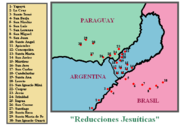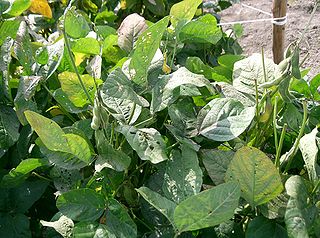
Santiago, Paraguay
Encyclopedia
Santiago is a city of Paraguay
, located in the Misiones department
. It is one of the most important Jesuit missions.
 “Santiago” or “Santiado de las Misiones” was founded originally in the banks on the Apa River with the name “San Ignacio de Caaguazú”. Later was re-founded in 1669 in the place where is today with the name of “Santiago Apóstol”.
“Santiago” or “Santiado de las Misiones” was founded originally in the banks on the Apa River with the name “San Ignacio de Caaguazú”. Later was re-founded in 1669 in the place where is today with the name of “Santiago Apóstol”.
It is an old Jesuit Mission and still today preserves many characteristics of the colonial time, like its great main square, the “house of the Indians” and a museum that preserves objects of art from colonial times.
During colonial times Santiago was a very important city because of its population, about 3,000 inhabitants.
It is important to mention that during the holidays it was organized the Opera of Santiago.
, capital of the country. It is located on a hill, between Ayolas
and San Patricio.
, sugar cane, cotton
and soy.
 It has an interesting museum of sacred art, the “Museo Jesuítico de Santiago” (Jesuit Museum of Santiago).
It has an interesting museum of sacred art, the “Museo Jesuítico de Santiago” (Jesuit Museum of Santiago).
The church preserves many images carved in wood by the natives. The “House of the Indians” is also a museum that exhibits images of saints. The church has a unique altarpiece in the Missions; there are also many pictures of biblical themes.
The Benedictine monastery “Tupasy María” is a beautiful place of meditation, it was founded in 1984.
The inhabitants of this city preserve the old traditions and in January it is celebrated the “Fiesta Tradicional Misionera” (Missioner Traditional Festivity), when artists and horse breaker from Paraguay, Argentina
, Brazil
and Uruguay
, show their abilities in breaking-in and horseracing. In this event traditional Paraguayan food is always present, some of the dishes are mbejú
and chipa. This festivity usually attracts many tourists.
The State “Tacuatí” is place for the Festival of Breaking-in and Folklore, located 270 kilometers from Asunción, to the south, in the road to Ayolas.
The Tambo Curupay is an inn where people can stay in their visit to the city, practice sports and take strolls in the country.
Paraguay
Paraguay , officially the Republic of Paraguay , is a landlocked country in South America. It is bordered by Argentina to the south and southwest, Brazil to the east and northeast, and Bolivia to the northwest. Paraguay lies on both banks of the Paraguay River, which runs through the center of the...
, located in the Misiones department
Misiones Department
Misiones is a department located in the southern region of Paraguay. Its capital is San Juan Bautista. The eighth of Paraguay's 17 departments, it was created in 1906, then known as the San Ignacio Department, and was not given its present name until 1945...
. It is one of the most important Jesuit missions.
Toponymy
Santiago was founded as “San Ignacio de Caaguzú”, near the Apa River, it was re-founded in the Misiones department, Paraguay, in 1669 with the name of “Santiago Apóstol”.History

It is an old Jesuit Mission and still today preserves many characteristics of the colonial time, like its great main square, the “house of the Indians” and a museum that preserves objects of art from colonial times.
During colonial times Santiago was a very important city because of its population, about 3,000 inhabitants.
It is important to mention that during the holidays it was organized the Opera of Santiago.
Geography
It is located 278 kilometers from AsunciónAsunción
Asunción is the capital and largest city of Paraguay.The "Ciudad de Asunción" is an autonomous capital district not part of any department. The metropolitan area, called Gran Asunción, includes the cities of San Lorenzo, Fernando de la Mora, Lambaré, Luque, Mariano Roque Alonso, Ñemby, San...
, capital of the country. It is located on a hill, between Ayolas
Ayolas
Ayolas is a city in the department of Misiones, Paraguay. It is also the name of the district that the city is located in.- Toponymy :The city takes its name on behalf of Juan de Ayolas, second of Pedro de Mendoza, who founded Puerto la Candelaria, now Fuerte Olimpo, on the Paraguay River...
and San Patricio.
Climate
In summer, the temperature reaches 39°C, in winter drops to 0°C. The annual average is 21°C.Population
Santiago has a population of 7,702 inhabitants, 4,017 men and 3,685 women, according to the General Direction of Polls, Statistics and Census.Economy
The people of Santiago dedicate mostly to cattle. Also to the agriculture and sow cornMaize
Maize known in many English-speaking countries as corn or mielie/mealie, is a grain domesticated by indigenous peoples in Mesoamerica in prehistoric times. The leafy stalk produces ears which contain seeds called kernels. Though technically a grain, maize kernels are used in cooking as a vegetable...
, sugar cane, cotton
Cotton
Cotton is a soft, fluffy staple fiber that grows in a boll, or protective capsule, around the seeds of cotton plants of the genus Gossypium. The fiber is almost pure cellulose. The botanical purpose of cotton fiber is to aid in seed dispersal....
and soy.
Municipality
It was re-founded in 1669 where is located today with the name of “Santiago Apóstol”. The current governor is Américo Romero Sanabria (Liberal Party).Tourism

The church preserves many images carved in wood by the natives. The “House of the Indians” is also a museum that exhibits images of saints. The church has a unique altarpiece in the Missions; there are also many pictures of biblical themes.
The Benedictine monastery “Tupasy María” is a beautiful place of meditation, it was founded in 1984.
The inhabitants of this city preserve the old traditions and in January it is celebrated the “Fiesta Tradicional Misionera” (Missioner Traditional Festivity), when artists and horse breaker from Paraguay, Argentina
Argentina
Argentina , officially the Argentine Republic , is the second largest country in South America by land area, after Brazil. It is constituted as a federation of 23 provinces and an autonomous city, Buenos Aires...
, Brazil
Brazil
Brazil , officially the Federative Republic of Brazil , is the largest country in South America. It is the world's fifth largest country, both by geographical area and by population with over 192 million people...
and Uruguay
Uruguay
Uruguay ,officially the Oriental Republic of Uruguay,sometimes the Eastern Republic of Uruguay; ) is a country in the southeastern part of South America. It is home to some 3.5 million people, of whom 1.8 million live in the capital Montevideo and its metropolitan area...
, show their abilities in breaking-in and horseracing. In this event traditional Paraguayan food is always present, some of the dishes are mbejú
Mbeju
Mbeju is a starch cake sometimes made with fariña or manioc flour.The high-calorie mbeju is a staple of the Paraguayan diet. According to scholars of Paraguayan social history, the popular Paraguayan diet evolved as a result of the War of Paraguay in the nineteenth century. In the aftermath of the...
and chipa. This festivity usually attracts many tourists.
The State “Tacuatí” is place for the Festival of Breaking-in and Folklore, located 270 kilometers from Asunción, to the south, in the road to Ayolas.
The Tambo Curupay is an inn where people can stay in their visit to the city, practice sports and take strolls in the country.

